At very beginning of the 12th century B.C. - the beginning of the period archaeologists call Iron Age I - the Sea Peoples swept out of the Aegean to make their appearance in the archeological record and in ancient literary references. The Philistines ultimately settled on and dominated some of the choicest land in Canaan - the agriculturally rich coastal strip from Gaza in the south to Tell Qasile, near modern Tel Aviv, in the north - through which passed one of the world's most important international trade routes. Soon the Philistines began exerting pressure on the Israelite tribes farther inland. This conflict prompted the Israelites to form a monarchy in the mid - 11th century in order to meet the Philistine threat more effectively. After about 150 years of dominance in the area, the Philistines faded from the scene - overpowered by the Israelites under King David - and thereafter played only a minor role in events until, in about 600 B.C., they disappeared altogether.
Archaeology has brought the Philistines to life more vividly than perhaps any other Biblical people save the Israelites and the Egyptians. We now know that the Philistines were one of the Sea Peoples that also include the Tjeker, the Denhen (or Danuna), the Shardana and the Weshesh. At the very beginning of the 12th century B.C. - the beginning of the period archaeologists call Iron Age I - the Sea Peoples swept out of the Aegean to make their appearance in the archeological record and in ancient literary references.
The Philistines ultimately settled on and dominated some of the choicest land in Canaan - the agriculturally rich coastal strip from Gaza in the south to Tell Qasile, near modern Tel Aviv, in the north - through which passed one of the world's most important international trade routes. Soon the Philistines began exerting pressure on the Israelite tribes farther inland. This conflict prompted the Israelites to form a monarchy in the mid-11th century in order to meet the Philistine threat more effectively. After about 150 years of dominance in the area, the Philistines faded from the scene - overpowered by the Israelites under King David - and thereafter played only a minor role in events until, in about 600 B.C., they disappeared altogether.
Exactly how the Philistines arrived in Canaan remains a problem. The regnant theory is that they were placed there by the Egyptians as garrison troops, or mercenaries, at a time when Egypt dominated Canaan. I believe it can now be demonstrated that they came instead as conquerors, replacing the Egyptians as the major power in the region.
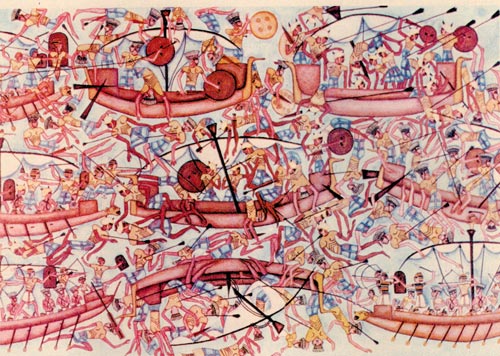
Trafalgar on the Mediterranean. Egyptian and Sea Peoples warriors clash in an epic naval battle in about 1177 B.C. The scene is preserved on the walls of Medinet Habu, mortuary temple of Pharaoh Ramesses III. The color drawing (above), based on the reliefs (below), provides an easier-to-see view of the engagement. In the drawing the Sea Peoples, of whom the Philistines are the best-known, are at center and right, identifiable by their feathered headdresses, standing upright like brushes.
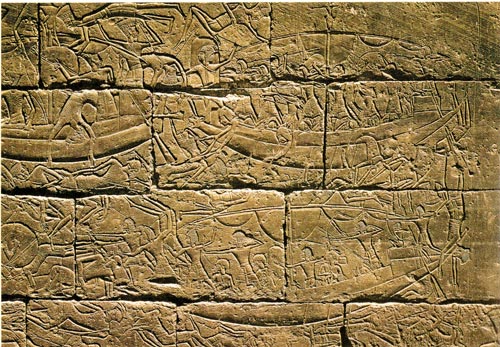
In the hieroglyphic text accompanying the Medinet Habu relief and in a papyrus document now known as Papyrus Harris I, Ramesses III boasted of a great victory of the Sea Peoples. The archeological evidence however, writes author Bryant Wood, reveals a steady Sea Peoples advance south along the coast of Canaan to the very borders of Egypt itself. After being halted there in a standoff against Ramesses III's forces in the battle depicted at Medinet Habu, the Sea Peoples settled in Canaan, becoming a dominant power there until the rise of the united Israelite kingdom under King David. Much of what we know about the Philistines appearance in Canaan is based on hieroglyphic texts and pictorial reliefs in the magnificent mortuary temple of Pharaoh Ramesses III (c. 1184 - 1153)1 at Medinet Habu in the Theban necropolis in Egypt. There we learn of a major confrontation between the Egyptians and a coalition of displaced groups referred to as the "Sea Peoples." This confrontation took place in the eighth year of Ramesses III, that is, about 1177 B.C.
The Sea Peoples made a two-pronged attack on the Egyptians, by land and by sea. Ramesses admits that the invading land forces reached the very border of Egypt: "Those who reached my boundaries, their offspring are not existent,"2 he says. The sea battle also took place on Egypt's doorstep. The fighting occurred, we are told, in the "river mouth," which can only refer to the estuaries of the Nile in the Egyptian Delta.3 Ramesses claims that he "capsized and overwhelmed" this naval force.
Below the reliefs depicting the sea battle, we see rows of prisoners being led into captivity. As Ramesses presents them to the gods, he boasts "My strong arm has overthrown (those) who came to exalt themselves."4
Ramesses maintains that he won a great victory. But this presents a difficulty. If he so utterly destroyed the Philistines as he alleges, how is it that they settled in some of the choicest real estate in the province of Canaan?
Scholars have resolved this discrepancy by theorizing that the Egyptians placed the Philistines in Canaan as military vassals, or mercenaries. This idea appears to have originated with the great American archaeologist William F. Albright. In his seminal excavation at Tell Beit Mirsim from 1926 to 1932 Albright was able to divide the Bronze and Iron Ages due to clear destruction layers. His subdivisions became the standard in Palestinian archaeology and remain so to the present day.
By relating historic events to a number of strata, Albright was able to assign absolute dates to each stratum. Phase B2, for example, was dated to the mid-12th century B.C. since Philistine pottery first appears in this phase. In his discussion of the date of the entry of the Philistines into Canaan, Albright planted the seed of the garrison-troop theory to explain the emergence of the Philistines in Canaan: "The Philistines were evidently settled in the Coastal Plain by permission of the Pharaoh, as becomes clear from his [Ramesses III's] inscriptions [at Medinet Habu]."5
The famous German scholar Albrecht Alt adopted this theme in his writings.6 Albright later added the idea that the Philistines were probably utilized as military vassals or garrison troops by the Egyptians.7 Then, in 1959 and 1966, a leading American scholar, G. Ernest Wright of Harvard University, further elaborated on the theory.8 It has now been generally accepted by most scholars.9
The most complete statement of the theory was recently outlined by the Israeli Egyptologist Itamar Singer:
Rameses [III] settled thousands of [Sea Peoples] prisoners in Egyptian fortresses and allotted clothing and provisions to them from the royal treasuries and grainaries. Although the text [Papyrus Harris I*] is not explicit with regard to the location of these strongholds, most scholars have assumed that the recruits, or at least some of them, were sent to Egyptian military posts in Canaan, where they served as garrison troops defending Egyptian interests against further sea-borne invasions and hostile elements in Canaan itself (italics added).10
The text on which the garrison-troop theory rests is found in a scroll known as Papyrus Harris I. This document records in great detail the accomplishments of Ramesses III throughout his long reign of 31 years. Written shortly after his death, it is the longest extant papyrus from ancient Egypt. As such, it constitutes the most complete record of the reign of any Egypian pharaoh. The section we are concerned with (column 76, lines 6-9) states:
I extended all the frontiers of Egypt and overthrew those who attacked them from their lands. I slew the Denyen in their islands, while the Tjeker and the Philistines were made ashes. The Sherden and the Weshesh of the Sea were made non-existent, captured all together and brought in captivity to Egypt like the sands of the shore. I settled them in strongholds, bound in my name. Their military classes were as numerous as hundred-thousands. I assigned portions for them all with clothing and provisions from the treasuries and granaries every year. 11
A careful reading of this text will show, I believe, that it cannot be relied on to support the garrison-troop theory of the Philistine settlement in Canaan. Note first the text states the Philistines "were made ashes,"12 not that they were taken captive. It was other Sea People - the Sherden and the Weshesh - who were taken captive, according to the papyrus. Moreover, as the reliefs at Medinet Habu illustrate and the Papyrus Harris I reports, these captives were bound and taken to Egypt where they were settled in "strongholds." Note that the strongholds were in Egypt. Thus Itamar Singer is incorrect when he states that "the text is not explicit with regards to the location of these strongholds."
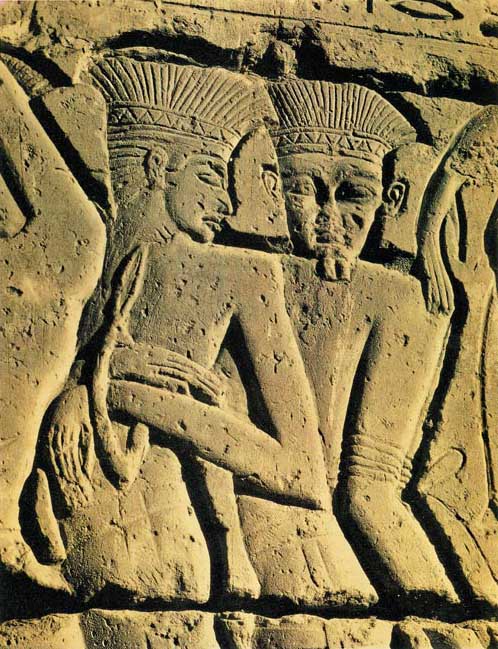 Egyptian P.R. Portraits of captured Philistines, referred to in Egyptian as Peleset, cover the walls of the Medinet Habu temple. At left in the photo, a Philistine prisoner is shown with his hands bound. He is part of a procession of captives above whose heads a hieroglyphic text (not shown in this photo) reads, "The words spoken by the fallen ones of Peleset, 'Give us the breath for our nostrils thou king, son of Amon.'" Many scholars have accepted Ramesses III's claims of victory against the Sea Peoples and have theorized that he subsequently allowed them to settle in Canaan under his tutelage. But a careful reading of Ramesses' pronouncements is inconsistent with this scenario. Author Wood argues that Ramesses was engaging in formulaic boasting and that the Sea Peoples came to Canaan not as vassals of pharaoh but as conquerors.
Egyptian P.R. Portraits of captured Philistines, referred to in Egyptian as Peleset, cover the walls of the Medinet Habu temple. At left in the photo, a Philistine prisoner is shown with his hands bound. He is part of a procession of captives above whose heads a hieroglyphic text (not shown in this photo) reads, "The words spoken by the fallen ones of Peleset, 'Give us the breath for our nostrils thou king, son of Amon.'" Many scholars have accepted Ramesses III's claims of victory against the Sea Peoples and have theorized that he subsequently allowed them to settle in Canaan under his tutelage. But a careful reading of Ramesses' pronouncements is inconsistent with this scenario. Author Wood argues that Ramesses was engaging in formulaic boasting and that the Sea Peoples came to Canaan not as vassals of pharaoh but as conquerors.
Moreover, the language of this text is typical of that used to describe the taking of captives to Egypt, where they were placed in servitude. Other texts from the time of Ramesses III make this clear. For example, elsewhere in this same document (column 77, lines 3-6), Ramesses' victory over the Libyans is described in the following manner:
I caused that they [the Libyans] cease to tread upon the border of Egypt. I carried off the ones whom my knife spared as numerous captives, their women and their children like hundreds of thousands, their herds in the number of tens of thousands, their I established their leaders in strongholds upon my name. I gave to them commanders of hosts and tribal leaders, they being branded and made into slaves, they being stamped with my name, and their women and their children being treated likewise.13
The Libyan prisoners were placed in strongholds in Egypt, as were the Sea Peoples captives, and then branded and stamped with the name of pharaoh and made into slaves.
Another section of Papyrus Harris I describes the treatment of Shasu Bedouin captives from Edom, in trans-Jordan:
I destroyed the people of Seir [Edom] among the Bedouin tribes, I razed their tents; their people, their property, and their cattle as well, without number, pinioned and carried away in captivity, as the tribute of Egypt. I gave them to the Ennead of the gods, as slaves for their houses.14
Again, the captives were taken to Egypt where they become temple slaves.
Another text from the reign of Ramesses III also speaks of the treatment accorded to captives:
He causes them to cross the river, being brought to Egypt. They are placed [literally,made] in strongholds of the king. . . . They are made shield-bearers, charioteers, and retainers who bear the fan while following the king.15
The captives were removed to Egypt where they were placed in "strongholds of the king."
All these texts tell us that enemy captives were manacled, taken to Egypt and placed in camps where they were branded with the name of pharaoh and made slaves.16 There is no hint that the Philistines in particular or enemy captives in general were settled in large numbers in provinical areas as vassals.17
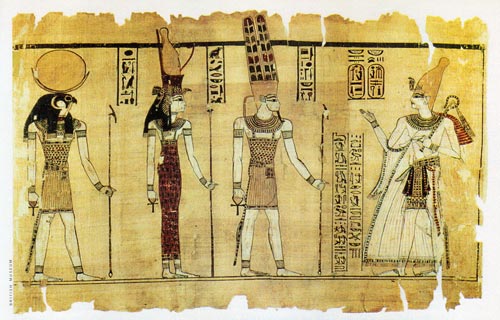
What is Papyrus Harris I? Papyrus Harris I (photo) is the largest and most magnificent of the papyri to survive from ancient Egypt. Along with four other scrolls, it was found by natives in 1855, in a hole in the floor of a cliff-tomb near Deir el Medineh, Thebes. The document was purchased by A. C. Harris of Alexandria, Egypt, hence its name. It is now in the possession of the British Museum.
The scroll is 133 feet long by 16-1/2 inches high and contains 117 columns of 12 or 13 lines each. It is a remarkable manuscript, written in beautiful large hieratic characters (a cursive form of Egyptian writing) befitting an original state document of the utmost importance. Practically in a perfect state of preservation, there is only one small piece of three lines torn out of the first column. There is little question that the papyrus was written immediately after the death of Ramesses III in about 1153 B.C. It was probably then deposited in the library of his mortuary temple at Medinet Habu.
Organized into seven main sections, Papyrus Harris I is a detailed statement of Ramesses' benefactions to gods and men during his reign of over 31 years. Ninety-five percent of the document deals with gifts and lists. The first section is an introduction, followed by three sections listing Ramesses' gifts to the major Egyptian temples at Thebes, Heliopolis and Memphis. At the beginning of each of these sections is a vignette, showing the king worshipping the gods to whom the following section is devoted. The text of each section is then introduced by a prayer, which merges into a recital of the king's building and other benefactions for the god, concluding with an appeal to him, calling attention to the following lists. These lists contain six different classes of material: (1) the god's estate; (2) his income; (3) the king's new gifts to him; (4) grain for the old feasts; (5) offerings for new feasts founded by him; and (6) offerings to the Nile-god.
This photo, for example, is of the beginning of the Theban section of Papyrus Harris. Ramesses III (right) the Egyptian deities Khonsu, Mut and Amon-Re. The accompanying text states, "I tell the prayers, praises, adorations, laudations, mighty deeds and benefactions which I did for thee, in thy presence, O lord of gods."
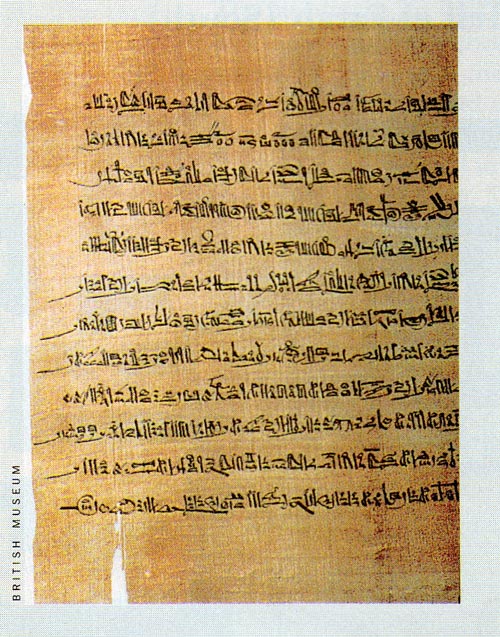
The fifth section is a general one devoted to offerings to smaller temples, followed by a section summarizing the king's generosity to the gods. Finally, the seventh and last section is a historical recitation of Ramesses' victories over his enemies. This is considered by most scholars to be an accurate record of his successes against the Sea Peoples, the Edomites and the Libyans. Author Bryant Wood, however, suggests in the accompanying article that Ramesses' claims regarding his supposed subjugation of the Sea Peoples is mere boasting and not a reliable historical account.
(Adapted from James Henry Breasted, Ancient Records of Egypt [Chicago: University of Chicago Press, 1906], vol. 4, pp. 87-92.)
So how did the Philistines come to settle in Canaan? Archaeological evidence from Israel and Sinai provides some, but not all, of the answers.
In the archaeological record, the arrival of Aegean newcomers in Canaan in about 1177 B.C. is well attested. Destruction levels of sites in the southwest coastal region mark the end of the Late Bronze Age architectural tradition. Then Aegean-style pottery suddenly appears. This pottery is usually found in a poor, squatter phase of occupation following the severe destruction of an Egyptian center or a Canaanite city.
The earliest pottery of this type is unique and easily identified. Scholars call it Mycenaean IIIC:1b ware, similar in all respects to a Mycenaean pottery made in the Aegean area. After a few decades, this monochrome pottery gave way to bichrome Philistine pottery, which was related to and developed from the Mycenaean pottery.** This Philistine pottery then continued in use for approximately 200 years.18
Sea Peoples calling card. At about the same time as the naval battle was taking place, a new type of pottery, such as the sherds and bowl shown above and below, made its debut in southwestern Canaan. Technically known as Mycenaean IIIC:1b or simply as monochrome pottery, it was made of local clays but followed closely the style of Aegean pottery of the same period. The name monochrome indicates that the pottery was decorated with a single color, usually red or black against a background. Monochrome pottery soon evolved into bichrome pottery (that is, decorated with two colors), the standard Philistine pottery for two centuries thereafter.
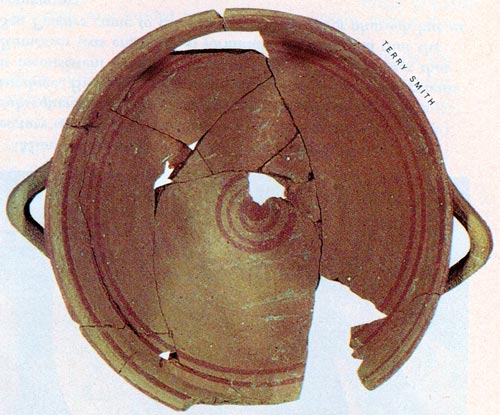
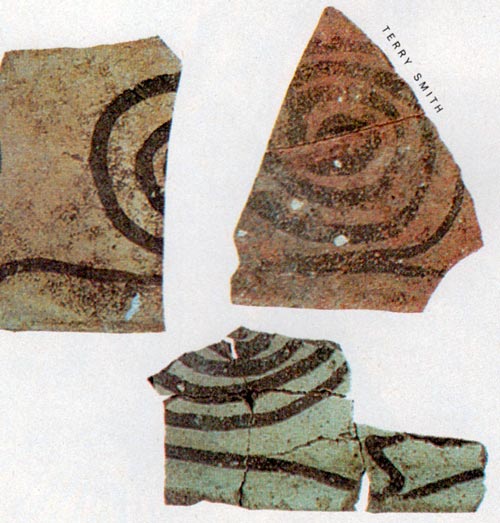
Monochrome pottery appears at Canaanite sites hand in hand with clear evidence of destruction at those sites. The conclusion is clear: The Sea Peoples arrived in Canaan early in the 12th century B.C., destroyed many formerly Egyptian settlements there and immediately began to settle into their newly conquered habitations - the first signs of which were the pottery styles they had brought with them from their Aegean homelands.
Tests have been performed on the Mycenaean IIIC:1b pottery to determine whether it was made of local clays and was therefore locally manufactured or whether it was imported. This test is known as neutron activation analysis. It measures the configuration of trace elements in the clay from which the pot was made by placing samples in a nuclear reactor and irradiating them with neutrons. A spectrometer then measures, or "counts," the energy levels given off by various radioactive trace elements. Each clay has a more or less destinctive signature of varying amounts of trace elements. By comparing clay samples in this way, it is often possible to identify the source of the clay used to make a particular vessel. ***
As a result of neutron actvation analysis, we know that both the Mycenaean pottery and Philistine pottery were locally made - in Canaan!19 This is especially instructive with regard to the Mycenaean ware, because this indicates that it must have been made by foreign potters who migrated to Canaan. The new people apparently had among their number skilled potters who began practicing their craft as soon as they settled in Canaan.
This is not what one would expect of Egyptian captives serving as garrison troops. Captives, according to Papyrus Harris I, were supplied with provisions from government depots and therefore would not be making their own pottery. This locally made Mycenaean pottery is the mark of immigrants coming into a new area with their culture, and at least a segment of their socioeconomic system, intact.
Even more important is where this Mycenaean pottery appears within the archaeological record. It is not found in functioning Egyptian fortresses, but rather in the next phase of occupation after an Egyptian or Canaanite phase. This new material culture is not found in conjuction with Egyptian artifacts at all. The two material culture assemblages are mutually exclusive!
Let us look at some of the relevant sites. Perhaps the most important is Tell el-Farah (south), a well-known site in southern Palestine excavated in 1928 by Sir William Flinders Petrie, the so-called father of Palestinian archaeology.20 Albright relied especially on evidence from Tell el-Farah (south) to support his garrison-troop theory.21 At Tell el-Farah (south) Petrie found a large late 13th- early 12th-century structure that he identified as an Egyptian "residency" because of its architecture and the large number of Egyptian artifacts associated with it. Since Philistine pottery was found in and around the edifice, which we, following Petrie, shall call building YR, all investigators have concluded that the building remained in use until the end of the 12th or even into the 11th century B.C.22 Therefore, it has been assumed that the Philistines were present here during the occupation of building YR and were under the control of the Egyptians.
A careful review of the stratigraphy of the site, however, shows that this was not the case.
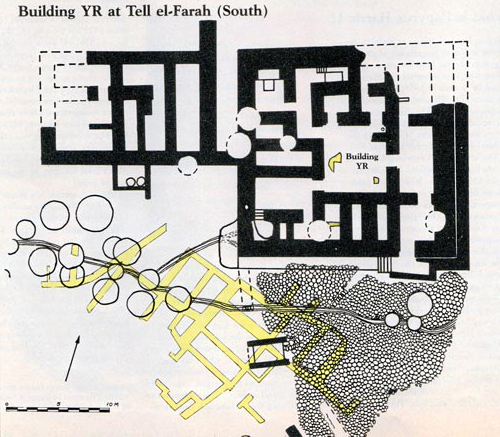
Three layers in one. This plan shows three distinct phases of occupation at Tell el-Farah (south), in southern Canaan. Black indicates a structure identifiable as Egyptian by its architecture and by the many artifacts found inside it. One artifact in particular, a sherd impressed with cartouches of Pharaoh Seti II proves that the building was still used by Egyptians early in the 12th century B.C. But in about 1177 B.C. this building was destroyed and replaced by temporary, squatter settlements. Most notably, circular pits containing Aegean-type pottery were dug in and near the building and its cobbled entrance court. A more permanent settlement at the site followed soon thereafter, indicated on the plan in yellow. Author Dr. Bryant Wood argues that the evidence from Tell el-Farah (south) meshes well with the pattern at several other coastal sites in southern Canaan. It indicates that the Sea Peoples were not - as has been assumed - posted to Canaan by the Egyptians but rather that they ousted the Egyptians from Canaan.
True, building YR was an Egyptian outpost; there is little doubt about this. But the question is, when did it cease to operate as an Egyptian outpost and what was the relation of the Aegean newcomers to this Egyptian outpost? Petrie found that building YR was destroyed in a massive conflagration.23 Following this destruction, squatters occupied the site as evidenced by flimsy cross walls constructed inside the ruined building,24 by pits dug in and around it and by domestic pottery, including Aegean types, found in the cobbled entrance court and an open area south of the west extension. The pits dug in the building and in the cobbled entrance court, especially those dug through the drainage system, give witness to the fact that these pits were dug after building YR ceased to be a functional unit. Moreover, domestic pottery would not have been in use in the entrance court and in an adjacent open area during the life of the building. The functional life of building YR as an Egyptian center therefore came to an end before the squatter phase with its Aegean-type pottery.
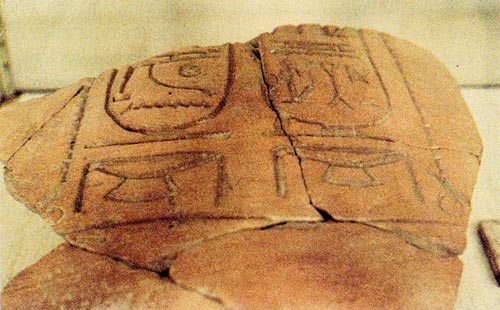
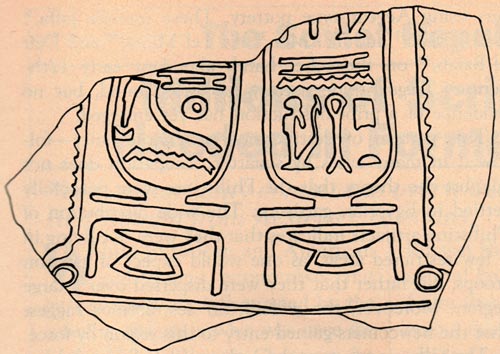
A vital clue. Cartouches - oblong rings containing hieroglyphs of a pharaoh's name - appear on a pithos, or large storage jar. Found in the structure at Tell-el-Farah (south) shown on the plan above, the cartouches with the name of Seti II (c. 1200-1194 B.C.) prove that the building was still used by Egyptians early in the 12th century B.C.
The next higher (and therefore the next later) stratum, identified in the excavation report as stratum X, was built over the entrance court of building YR and the area west of the entrance court. A number of walls from stratum X pass over the pits; it is therefore clear that many of these pits belong to a squatter phase that was later than building YR and earlier than the walls of stratum X. As it happens, this squatter phase can be dated quite accurately.
The earliest date for the destruction of building YR is provided by a large fragment of pottery bearing cartouches of Seti II. It was found in the entrance court and is part of a large pithos (storage jar). This pithos fragment is clearly associated with the use of the building rather than with the squatter phase that followed. Because Seti II ruled from about 1200 to 1194 B.C., building YR must have been destroyed sometime after 1200 B.C. A very close date for stratum X can be obtained from the pottery associated with this phase. It is characteristic of the second half of the 12th century B.C.25 The squatter phase, in between, must therefore date sometime between 1200 B.C. and the mid-12th century B.C.26
The conclusion is clear: Building YR was destroyed in the early 12th century by people who had strong affinities with the Aegeans and who then occupied the site as squatters until substantial buildings were erected in the second half of the 12th century. It is most logical to assume that the site was destroyed by the Sea Peoples in about 1177 B.C., as they made their way south, toward Egypt.
Another site that follows this same pattern is site A-289 discovered by the Ben-Gurion University expedition when they surveyed the northern Sinai between 1972 and 1982. It is located approximately 7.5 miles east of El Arish and was excavated between 1979 and 1981 under the direction of Eliezer Oren. To date, only a short preliminary report has been published on this very important site.27 The large structure comprising site A-289 was undoubtedly one of the Egyptian fortresses along the Ways of Horus, the overland coastal route between Egypt and Canaan. The fortress was destroyed in the early 12th century, with evidence of severe burning.28 Following the destruction, there was squatter occupation, as attested by numerous pits inside the fortress.29
As at Tell le-Farah (south), a pithos with the cartuoches of Seti II was found, along with fragments of a second, similarly inscribed, pithos.30 In the destruction debris was a bell shaped bowl of Mycenaean IIIC ware.31 It appears that site A-289 was another victim of the Sea Peoples as they made their way along the Way of Horus toward Egypt.
The same sequence of violent destruction followed by early 12th-century Aegean-type pottery was also found at Ashdod32, Gezer,33 Ashkelon34 and Tell Jemmeh.35 Other sites were destroyed at this time, but without evidence of a subsequent settlement of squatters using Aegean-type pottery. These include Jaffa36, Tell Jerishe37 and Mor.38 At Tel Tel Miqne39 and Deir el-Balah,40 on the other hand, abundant early 12th-century Aegean-type pottery has been found, but no evidence of a prior destruction has yet emerged.
This pattern of destruction - or discontinuity - followed in many cases by squatter occupation does not support the theory that the Philistines were peacefully settled in Egyptian garrisons. The wide distribution of Philistine artifacts indicates that they were not living in a few restricted areas, as one would expect of garrison troops, but rather that they were dispersed over a large region. Moreover, the widespread destructions suggest that the newcomers gained entry to this region by force.
The following factors also indicate that Egypt did not relinqish this area to the newcomers willingly: (1) the area of the Philistine settlement was prime agricultural land; (2) it sat astride the major land route through the country; (3) it was adjacent to Egypt's major sea-lane and (4) it included the primary Egyptian administrative center for the northern territories, Gaza.
With one exception (Tel Mor),41 there is no evidence of an Egyptian presence in the area of Philistia after the entry of the Philistines. Inland, however, Egypt maintained centers at Beth-Shean, Megiddo, Lachish and Tell esh-Sharia for several decades after the entry of the Philistines.42
It appears that the Egyptians and the Philistines peacefully coexisted for a time, albeit in different areas, before the Egyptians were forced to abandon their northern holdings altogether. The archeological data do not tell us how this state of affairs came about; we can only speculate. One thing is certain, however; the archaeological data do not support the theory that the Philistines were peacefully settled in Canaan as Egyptian garrison troops.

The Sea Peoples' March to Egypt. Conquering as they moved south, the Sea Peoples destroyed many Egyptian sites, until their advance was halted in the naval and land engagements depcited at Medinet Habu. The Sea Peoples then retraced their steps and settled permanently at many of the sites they had recently vanquished. Their hegemony in coastal Canaan would go unchallenged for a century and a half, until the rise of the Israelites under King David.
It appears that the Philistines systematically destroyed the Egyptian and Canaanite centers in their path as they made their way south along the Canaanite coast toward Egypt. Once at the border, they were driven back by Egyptian forces as depicted in the battle scenes at Medinet Habu and as referred to in Papyrus Harris I. Apparently they then retraced their steps to the southwest coastal region of Canaan where they settled on the ruins of the sites they had recently devastated.43 Whether this was by treaty arrangement or by tacit understanding we do not know.
Following the Egyptian retreat from Canaan in the mid-12th century (marked by the destruction of Egyptian strata at a number of sites), the Philistines became the major power in the region, a position they maintained until they were finally overpowered by the Israelites in the time of King David.
The entry of the Philistines becomes the most logical time to define the end of the Late Bronze Age and the beginning of the Iron Age in Palestine.44 Politically, the Philistine invasion marks the end of Egyptian preeminence in the area and the beginning Philistine ascedancy. The Philistines remained the dominant force in Canaan for the next 150 years, when they were in turn supplanted by the Israelites.
This article is a revised version of a paper presented at the annual meeting of the American Schools of Oriental Research in Chicago, November 19, 1988. Published in Biblical Archaeology Review, Nov.-Dec. 1991. Posted with permission.
Footnotes:
*The Roman numeral distinguishes this payrus from others obtained by Harris.
**See Lawrence E. Stager, "When Canaanites and Philistines Ruled Ashkelon," BAR, March/April 1991; and Trude Dothan and Seymour Gitin, "Ekron of the Philistines," BAR, January/February 1990.
***See Maureen F. Kaplan, "Using Neuton Activation Anaalysis to Establish the Provenance of Pottery," BAR, March 1976.
1. Throughout this article, I follow the chronology of Kenneth A. Kitchen in "The Basics of Egyptian Chronology in Relation to the Bronze Age" from High, Middle or Low? Acts of an International Colloquium on Absolute Chronology, Part I, ed. Paul Astrom (Gothenburg, Sweden: Paul Astroms Forlag, 1987), pp. 37-55.
2. Manfred Bietak, "Response to T. Dothan," in Biblical Archaeology Today, ed. Janet Amitai (Jerusalem: Israel Exploration Society, 1985), p. 217; N.K. Sandars, The Sea Peoples: Warriors of the Ancient Mediterranean 1250-1150 BC (London: Thames and Hudson, rev. ed., 1985), p. 120.
3. John A. Wilson, "Egyptian Historical Texts," in Ancient Near Eastern Texts Relating to the Old Testament (ANET), ed. James B. Pritchard (Princeton, NJ: Princton Univ. Press, 3rd ed., 1969), p. 262, n. 6; Bietak, "Response to T. Dothan," p. 217; Sandars, The Sea Peoples, p. 124.
4. Sandars, The Sea Peoples, p. 131.
5. William F. Albright, The Excavation of Tell Beir Mirsim in Palestine, vol. 1: The Pottery of the First Three Campaigns, Annual of the American Schools of Oriental Research (ASOR) 12 (New Haven, CT: ASOR, 1932), p. 58.
6. Albright Alt, "Agyptische Tempel in Palastina und die Landnahme der Philister," in Kleine Schriften zur Geschichte des Volkes Israel I (Munich: C.H. Beck, 1953), pp. 227-228; cf. Martin Noth, The History of Israel (New York: Harper & Row, 2nd ed., 1960), p. 36.
7. Albright, "The Biblical Period," in The Jews: Their History, Culture and Religion, ed. L. Finkelstein (New York: Harper & Bros., 3rd ed., 1949), pp. 19 and 58, n. 49 (reprinted as The Biblical Period From Abraham to Ezra, 1963); "Syria, Philistines and Phoenicia," in Cambridge Ancient History (CAH), ed. I.E.S. Edwards et al.(Cambridge UK: Cambridge Univ. Press, 1975) vol. 2, part 2, pp. 509-511. (Although this chapter in CAH was not published until 1975, it was written before 1950; see Albright, "Some Oriental Glosses on the Homeric Problem," American Journal of Archaeology 54 [1950], p. 170, n. 31.)
8. G. Ernest Wright, "Philistine Coffins and Mercenaries," Biblical Archaeologist (BA) 32 (1959), pp. 53-66; reprinted in The Biblical Archaeologist Reader, ed. E.F. Cmpbell and David Noel Freedman (Garden City, NY: Doubleday, 1964), vol. 2 pp. 59-68; and "Fresh Evidence for the Philistine Story," BA 29 (1966), pp. 70-86.
9. See, for example, Abraham Malamat, "The Egyptian Decline in Canaan and the Sea Peoples," in World History of the Jewish People, vol. 3: Judges, ed. B. Mazar (London: W.H. Allen, 1971), p. 34; Benjamin Mazar, "The Philistines and Their Wars with Israel," in World History, vol. 3, p. 170; Roland de Vaux, The Early History of Israel, transl. D. Smith (Philadelphia: Westminster, 1978), pp. 493, 509; Trude Dothan, The Philistines and Their Material Culture (New Haven, CT: Yale University Press, 1982), p. 3, and "The Philistines Reconsidered," in Biblical Archaeology Today, pp. 170, 172. Note, however, the reservations of V.A. Desborough (The Last Mycenaeans and Their Successors: An Archaeological Survey c. 1200 - c. 1000 B.C. [Oxford: Clarendon, 1964], p. 209) and Richard D. Barnett, "The Sea Peoples," in CAH, p. 378.
10. Itamar Singer, "The Beginning of Philistine Settlement in Canaan and the Northwest Boundary of Philistia," Tel Aviv 12 (1958), p. 109.
11. Wilson, "Egyptian Historical Texts," p. 262.
12. Interestingly, the other group to be "made ashes," the Tjeker, also settled along the coast of Canaan, north of the area occupied by the Philistines. In the Wen-Amon tale (c. 1100 B.C.), they controlled Dor, about 15 miles south of Haifa, and were ruled by a prince named Beder (see Wilson, "Egyptian Myths, Tales, and Mortuary Texts, in Pritchard, ANET, p. 26).
13. A.R. Schulman, Military Rank, Title and Organization in the Egyptian New Kingdom, Muncher Agyptologische Studien 6 (Berlin: Bruno Hessling, 1964), p. 123, text 234.
14. Wilson, "Egyptian Historical Texts," p. 262.
15. Schulman, Military Rank, Title and Organization, p. 123, text 236.
16. On the north wall of the first court of the Medinet Habu temple is an account of a campaign to Syria describing the handling of captives. In actual fact, this campaign probably never took place since it is not recorded in Papyrus Harris I. In all likelihood, the texts were copied from originals of the reign of Ramesses II. Nevertheless, they reflect the normal treatment of captured enemies in the time of Ramesses III: "Collect the captives whom the valor of Pharaoh, life, prosperity, health, has taken, and place them [in] the offices in the house of Amon-Re . . . I have carried them away: the males thereof to fill thy storehouse; their women to be subjects to thy temple" (in James Henry Breasted, Ancient Records of Egypt [Chicago: University of Chicago Press, 1906], vol. 4, p. 71). As in the previous examples cited, the captives were transported to Egypt and pressed into bondage.
17. It should be pointed out that the Shardana are known to have served as mercenaries in the Egyptian army in the Amana period (mid-14th century B.C.) and in the reigns of Ramesses II (1279-1213 BC) and III. In facct, Shardana mercenaries participated in Ramesses' battle against the Sea Peoples (Sandars, The Sea Peoples, pp. 120, 125). Conditions for the Shardana mercenaries were much different than those of the Shardana captives:
"I made the infantry and chariotry to dwell [at home] in my time; the Sherdana and Kehek were in their towns, lying the length of their backs; they had no fear, for there was no enemy from Kush [nor] from Syria. Their bows and their weapons were laid up in their magazines, while they were satisified with drunk and joy. Their wives were with them, their children at their side [for] I was with them as the defense and protection of their limbs" (Papyrus Harris I; Sandars, The Sea Peoples, p. 133).
The employment of Sea Peoples mercenaries in the Egyptian army is quite a different phenomenon, however, than the mass settlements that occurred in Canaan following the battle of Ramesses' eighth year (Sandars, The Sea Peoples, p. 111).
18. For further discussion of Mycenaean IIIC:1b ware, with references, see T. Dothan, "The Philistines Reconsidered," pp. 167-170; Amihai Mazar, "The Emergence of the Philistine Material Culture," Israel Exploration Journal (IEJ) 35 (1985), pp. 95-107; and "Excavations at Tell Qasile, pt. 2: The Philistine Sanctuary: Various Finds, The Pottery, Conclusions, Appendixes," Qedem 20 (1985), pp. 119-120.
19. Asaro, Isadore Perlman and Moshe Dothan, "An Introductory Study of Mycenaean IIIC1 Ware from Tel Ashdod," Archaeometry 13 (1971), pp. 169-175; Perlman and Asaro, "Provenience Studies on Pottery of Strata 11 and 10," in M. Dothan and Y. Porath, Ashdod 4: Excavation of Area M, 'Atiqot 15 (1982), pp. 70-90 (English series); J. Gunneweg et al., "On the Origin of Pottery from Tel Miqne-Ekron," Bulletin of the American Schools of Oriental Research 264 (1986), pp. 3-16.
20. William Flinders Petrie, Beth-Pelet 1 (Tell Fara), Publication No. 48 (London: British School of Archaeology in Egypt, 1930). For a synopsis of his career, see Joseph A. Callaway, "Sir Flinders Petrie, Father of Palestinian Archaeology," BAR, November/December 1980. In 1929 James L. Starkey and G. Lankester Harding also excavated this site ("Beth-Pelet Cemetery," in Beth-Pelet 2, ed. E. MacDonald, Starkey and Harding, Publication No. 52 [London: British School of Archaeology in Egypt, 1932]).
21. Albright, "Syria, Philistines and Phoenicia," p. 510.
22. Starkey and Harding, "Beth-Pelet Cemetery," p. 31; Albright, "Syria, Philistines and Phoenicia," p. 510; Yael Yisraeli, "Tel Sharuhen," in Encyclopedia of Archaeological Excavations in the Holy Land (EAEHL), ed. M. Avi-Yonah and E. Stern (Englewood Cliffs, NJ: Prentice-Hall, 1978), vol. 4, p. 1077; T. Dothan, The Philistines and Their Material Culture, p. 27.
23. Petrie, Beth-Pelet 1, p. 18.
24. Petrie, Beth-Pelet 1, p. 18.
25. For a discussion of this pottery, see Bryant G. Wood, Palestinian Pottery of the Late Bronze Age: An Investigation of the Terminal LB IIB Phase, Ph.D. thesis, University of Toronto (Ann Arbor, MI: University Microfilms, 1985), p. 460.
26. For a full analysis of this pottery, see Wood, Palestinian Pottery of the Late Bronze Age, pp. 460-465.
27. Eliezer D. Oren, "The 'Ways of Horus' in North Sinai," in Egypt, Israel, Sinai: Archaeological and Historical Relationships in the Biblical Period, ed. Anson Rainey (Tel Aviv: Tel Aviv University, 1987), pp. 69-119.
28. Oren, "The 'Ways of Horus,'" p. 93.
29. Oren, "The 'Ways of Horus,'" p. 94.
30. O. Goldwasser, “An Egyptian Store Jar from Haruvit,” Qadmoniot 13 (1980), pp. 34 (in Hebrew).
31. Oren, “The Ways of Horus,” p. 96.
32. M. Dothan, Ashdod 2–3: The Second and Third Seasons of Excavations, 1963, 1965, ‘Atiqot 9-10 (1971), pp. 26-27 (English series); “Ashdod,” in EAEHL, vol. 1, p. 108; “Ashdod at the End of the Late Bronze Age and the Beginning of the Iron Age,” Symposia: Celebrating the Seventy-fifth Anniversary of the American Schools of Oriental Research (1900-1975), ed. F.M. Cross (Cambridge, MA: ASOR, 1979), pp. 126-131.
33. William Dever, H. Darrell Lance and Wright, Gezer 1: Preliminary Report of the 1964-66 Seasons (Jerusalem: Hebrew Union College (HUC) Biblical and Archaeological School in Jerusalem, 1970), pp. 22-26; Dever, et. al., Gezer 2: Report of the 1967-70 Seasons in Field I and II (Jerusalem: HUC/Nelson Glueck School of Biblical Archaeology, 1974), pp. 51-54.
34. W.J. Phythian-Adams, “Report on the Stratification of Askalon,” Palestine Exploration Fund Quarterly Statement (1923), pp. 171-176.
35. Gus W. Van Beek, “Tel Gamma 1971-1972,” IEJ 22 (1972), pp. 245-246; and “Tel Gamma 1975-1976,” IEJ 27 (1977), pp. 171-176.
36. Jacob Kaplan, “Jaffa’s History Revealed by the Spade,” in Archaeological Discoveries in the Holy Land, ed. Archaeological Institute of America (New York: Bonanza Books, 1967), pp. 116-117; cf. J. Kaplan, “The Archaeology and History of Tel Aviv-Jaffa,” BA 35 (1972), pp. 81-82; Haya Kaplan and J. Kaplan, “Jaffa,” in EAEHL, vol. 2, p. 535.
37. Nahman Avigad, “Tel Jerishe,” in EAEHL, vol. 2, p. 578.
38. M. Dothan, “Excavations at Tel Mor (1959 Season),” Bulletin of the Israel Exploration Society 24 (1969), p. III.
39. Gitin and T. Dothan, “The Rise and Fall of Ekron of the Philistines,” BA 50 (1987), pp. 201-202. See also T. Dothan, “Ekron of the Philistines - Part 1: Where They Came From, How They Settled Down and The Place They Worshipped In,” BAR January/February 1990, p. 26.
40. T. Dothan, “Deir el-Balah, 1979, 1980,” IEJ 31 (1981), p. 129.
41. M. Dothan, “Tel Mor,” in EAEHL, vol. 3, p. 890.
42. Wood, Palestinian Pottery of the Late Bronze Age, pp. 582-592.
43. Bietak, “Response to T. Dothan,” p. 217.
44. Several phenomena are observed in the archaeological record at this time: the end of Late Bronze imported Cypriot and Mycenaean ware, a series of destructions along the Mediterranean coast, the termination of the Late Bronze architectural tradition at sites occupied by the Philistines and the introduction of a new type of pottery. All these factors combine to reinforce the Philistine horizon as the logical line of demarcation between the Late Bronze Age and the ensuing Iron I period.











